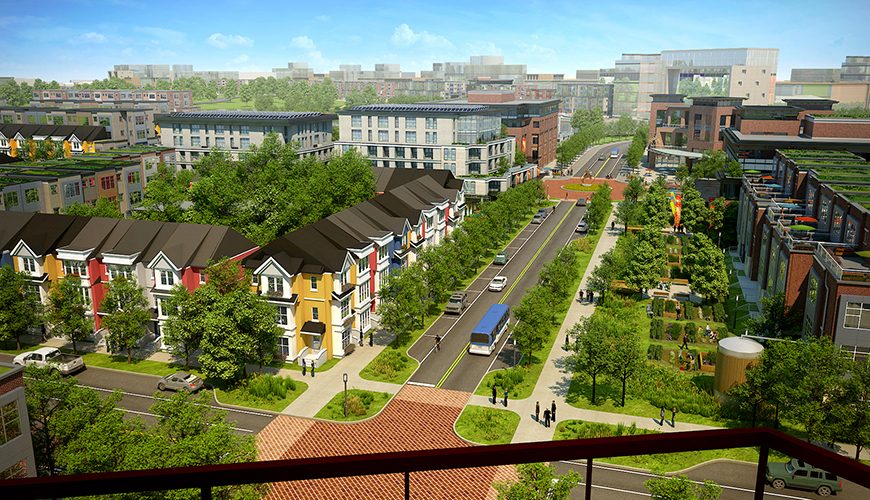The Heat Beneath Our Feet
Geo-exchange is the very definition of sustainable technology.

As the energy transition ramps up, some fossil-fuel companies are looking ahead with a sense of dread. The world is quickly adopting renewables, batteries and electrifying buildings and vehicles. Others are instead embracing the future. One of the country’s largest utilities, NextEra Energy Partners (part of NextEra Energy), announced it would sell its gas pipelines and invest the proceeds in more renewables.
One of the most obvious ways energy companies and large construction companies can decarbonize while remaining profitable is to sell us the heat beneath our feet. It’s easier to extract than oil and gas. I’m talking about geothermal energy for extraction companies and about geo-exchange and ground-source heat pumps for heating and cooling buildings.
Construction has begun at 1 Java St., near the East River in the Brooklyn borough of New York City, where five buildings totaling more than 800 residential rental units are to be built by 2025. Heating, cooling, domestic hot water, a swimming pool: all the site’s thermal energy needs will be provided by ground-source heat pumps fed by a big geothermal field beneath the buildings.
The geothermal consists of 320 boreholes, each drilled to about 500 feet in depth. It will save approximately 53% on energy each month. The geo wells last about 100 years; the ground-source heat pumps are upgraded roughly every 25 years.
The project is being underwritten by Australia-based developer Lendlease, and hundreds of similar projects are being planned or already breaking ground all over North America. New York has new emissions standards for large buildings that require emissions reductions of 40% by 2030 and 80% by 2050. The Java St. complex will be entirely net-zero.
Heat Pumps
As reported a few months ago, U.S. heat pump sales exceed gas furnace sales. That trend is expected to deepen, especially considering building code changes, city building standards such as those in New York and numerous incentives now available. U.S. sales are increasing by about 15% each year.
The International Energy Agency says annual sales of heat pumps in Europe could rise to 7 million by 2030, driven by the Ukraine war, up from 2 million in 2021. Sales are growing at about 35% per year. The World Economic Forum (WEF) says global CO2 emissions will likely be reduced by
500 million tonnes by 2030 as they replace gas, oil and coal. Some 247 billion cubic feet (bcf) of gas will go unburned, thanks to heat pumps, by 2025; it will increase to 741 bcf by 2030.
“Heat pumps have been around since the 1850s and have a higher efficiency than other traditional sources by taking heat to and from their surroundings,” the WEF notes. “They use electricity to generate heat more efficiently than other forms of heating, such as gas, oil and LPG boilers.”
It seems as if hardly a day goes by lately that we don’t hear about a new kind of heat pump or hybrid product in development or being launched to equip the buildings of the new world we’re building. Germany’s Vaillant recently introduced one operating on R290 (propane), a natural refrigerant with a global warming potential of 4.0.
Another company, Ecoflow, created Wave 2, a portable heater/cooler for small spaces also using R290 that pumps out 6,100 BTUs in heat mode and 5,100 BTUs in cooling mode. It’s promoted as suitable for small off-grid dwellings, vehicles, boats, tents and so on.
Net-Zero Cabin in Seattle
In the past 100 years, as the world population mushroomed from around 2 billion to about 8 billion, it has become increasingly chaotic. The proliferation of news and information feeds has made it clear to us how nutty it’s getting. Many people are seeking living arrangements to protect their sanity and seem to provide greater health and safety for their families.
Some choose remote living in the woods, while some choose an urban oasis that feels like a rural setting, despite being located within a city. Such is the case for a net-zero project we found in Seattle.
Net-zero and passive houses are sometimes described by cynics as windowless black boxes. Indeed, I’ve seen a few that are similar, but as engineers and architects know, designers willing to apply an open mind and some creativity to projects can find ways to create inspiring, highly livable spaces that meet any set of guidelines.
Heated by a single air-to-water heat pump, this 2,400-square-foot project in Seattle is still able to use numerous floor-to-ceiling, triple-pane windows while managing its heat load requirements. Solar on the roof makes it net-zero energy. Low-flow plumbing and the reuse of reclaimed fir siding and other materials from demolished structures make it even greener.
It was a new build designed by Olson Kundig Architects in collaboration with Dovetail General Contractors. The design employs a staggered footprint, optimal solar gain strategies and carefully planned landscaping, all adding to the possibilities for efficient heating/cooling and a leafy, backwoods feeling.
Anyone seeking an architect who creates residential and commercial structures that integrate beautifully with nature would do well to consider the Olson Kundig firm. It offers a solid portfolio of mostly low-carbon projects built all over the country and the world.
Geothermal in Canada
As mentioned, large geothermal communities similar to the aforementioned Brooklyn project are popping up more often. Canada offers four examples of such projects. The oldest one is in Richmond, British Columbia, where the Alexandra District Energy Utility was the city’s first district energy system in a neighborhood called Lulu Island.
It serves more than 2,200 units, 12 buildings and
2.3 million square feet of residential and commercial floor space. A Walmart is also connected to the system. Its two geo fields total 726 boreholes, each about 250 feet deep, connected to miles of underground distribution piping throughout the community.
Depending on energy demands, the heat pumps can either extract energy from the ground for heating or pump it back into the ground for cooling. Since its opening in 2012, it has undergone multiple expansions. Recently, a huge funding commitment was added. The expectation is that the area will soon boast 50 million square feet relying on zero carbon energy, mostly geo-exchange, but also some wastewater energy capture.
Meanwhile in Edmonton, Alberta, the Blatchford community continues to progress. The city grew quickly in the past few decades, leading to the relocation of its main airport from a downtown location to a larger area in the suburbs. For the city’s urban planners, it was a dream come true to reclaim a large expanse of land in the downtown core, where they were determined to create a mixture of affordable and market-rate housing and demonstrate a near-zero carbon approach.
The city already created part of what will be a massive geothermal system, eventually serving some 30,000 residents.
At the moment, Blatchford has taken a turn into “cautionary tale” territory because some of the partner developers did what developers often do — pushed their advantages and rights and established pricing about $100,000 higher than average in the city (despite the fact that the geo only increased costs by 6%).
After they exploded at the beginning, sales have slowed considerably. Talks are underway; I think, eventually, this project will get back on track, but there is a lesson to be learned here about developers wielding power and shooting themselves in the foot.
Two similar new projects are near Toronto in Ontario. One is called Lakeview Village and is to be built on the shore of Lake Ontario in Mississauga, just west of Toronto’s western suburb of Etobicoke. Like Blatchford, it will be mostly geothermal but also may include wastewater energy capture and a limited amount of gas for emergency backup. And it’s big, at 20,000 residents, and combines affordable with market-rate housing.
A smaller project of 300 houses using geo-exchange is under construction in Markham, just north of Scarborough, Toronto’s eastern suburb. In this case, it is a kind of pilot project by Mattamy Homes. It’s significant because although relatively small, Mattamy is no minor player; it is Canada’s largest residential home builder and a top-25 builder in the United States, too.
The Markham project represents its first significant foray into deep decarbonization. The hope is that it will become the model for all future Mattamy projects.
In the past, we’ve reported on similar geothermal communities in Texas, Florida, California, Georgia, North Carolina and Rhode Island. I’ve also written about the company Dandelion, which does ground-source retrofits in single-family homes — more than a thousand in the past few years in New York, Connecticut and Massachusetts.
Canada also has its share of these. In Ontario and Quebec, hundreds of single-family homes are heated and cooled by dedicated ground-source systems. Some made significant investments in the technology because it really is the Rolls Royce of HVAC, providing quiet, stable, zero-carbon heating and cooling. Once installed, the system requires minimal maintenance/service and offers very low operating costs.
I’ve been told that millennials and Gen Zers have no patience with boomers and the other oldsters who still control our world when it comes to debating and dithering instead of simply deploying clean energy on a broad scale. They seem to be long-term thinkers.
I hope they retain this tendency and create a better world as they become parents and grandparents. If so, they are likely to value geo-exchange because it is the very definition of sustainable technology.





